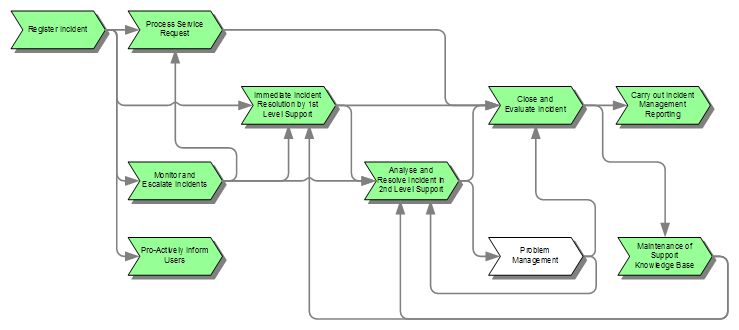Service Desk and Incident Management
| diese Seite auf Deutsch |
|---|
ITIL Version: ITIL Version 2 (ITIL V2)
Process Objective: The "Service Desk and Incident Management" process aims to restore IT Services to their defined Service Levels as quickly as possible The process is also responsible for receiving and processing Service Requests, for assisting users, and for coordinating the Incident Resolution with Specialist Support Groups. Throughout the process, users are informed at regular intervals about their Incidents' status.
Part of: Service Support
Process Owner: Incident Manager
Sub-Processes

- Register Incident
- Process objective: The Incident shall be recorded and documented in appropriate quality, in order to facilitate a swift and effective solution.
- Process Service Request
- Process objective: An Incident of the type Service Request is to be completely processed within the agreed resolution time.
- Immediate Incident Resolution by 1st Level Support
- Process objective: An Incident of the type Service interruption is to be solved within the agreed solution period. The aim is the fast recovery of the IT Service, where necessary with the aid of a Workaround. The solution is to take place, where possible, upon the first attempt by 1st Level Support; if this is not possible, the Incident is transfered to a suitable group within 2nd Level Support.
- Analyse and Resolve Incident in 2nd Level Support
- Process objective: If possible, the root cause of the Service interruption should be corrected, or at least a Workaround applied. If the correction of the root cause is not possible, a Problem Record is created and the error-correction transfered to Problem Management.
- Monitor and Escalate Incidents
- Process objective: The processing status of outstanding Incidents is to be continuously monitored, so that counter-measures may be introduced as soon as possible if Service Levels are likely to be breached.
- Pro-Actively Inform Users
- Process objective: The users are to be informed of detractions to the IT Services as soon as these are known to the Service Desk. The users are then placed in a position to adjust themselves to interruptions, and the number of inquiries by users is reduced.
- Close and Evaluate Incident
- Process objective: Before the final closure of the Incident, it is to be submitted to a quality-control with regards to the resolution. In addition to this, findings from the resolution of the Incident are to be recorded for the future.
- Maintenance of Support Knowledge Base
- Process objective: Findings from the processing of Incidents as well as information from other Service Management Processes are to be incorporated into the Support Knowledge Base in a structured and quality-assured manner, so that future Incidents can be more efficiently processed.
- Carry out Incident Management Reporting
- Process objective: It is to be ensured that (a) improvement potentials are derived from past Incidents, and (b) the other Service Management Processes have the information necessary from Incident Management that are required to fulfill their tasks.
Click here to view the complete set of process models describing the "Service Desk and Incident Management" process: An example how process modelling can be used in order to make the process dependencies transparent, while still defining processes in sufficient detail (this is an external link to the IT Process Maps web site).
Involved Roles
Related Checklists and KPIs
Checklists
- Checklist Incident Record
- Checklist Initial Analysis of an Incident
- Checklist Incident Priority
- Checklist Incident Escalation
- Checklist Closure of an Incident
- Checklist Incident Report
KPIs






